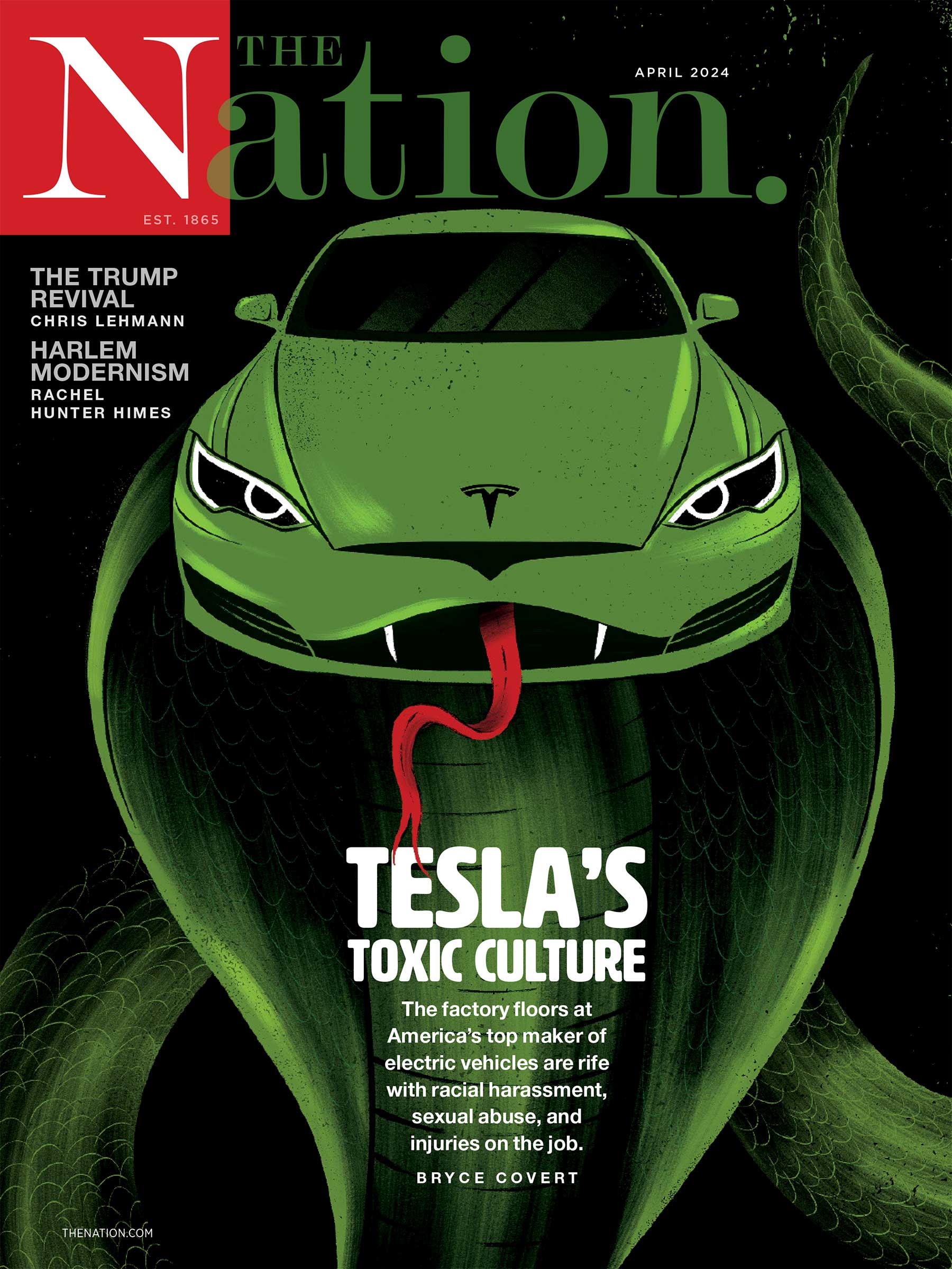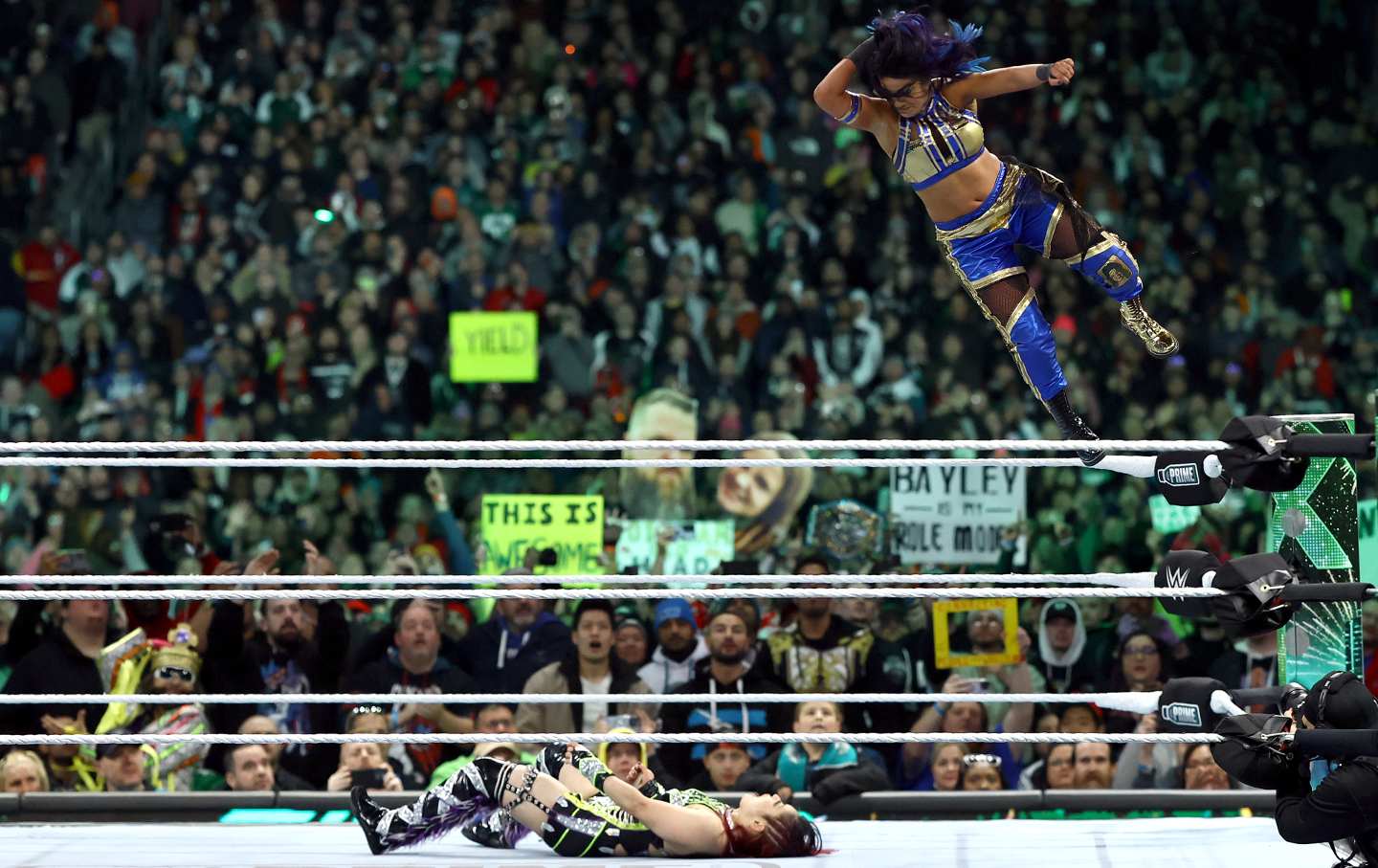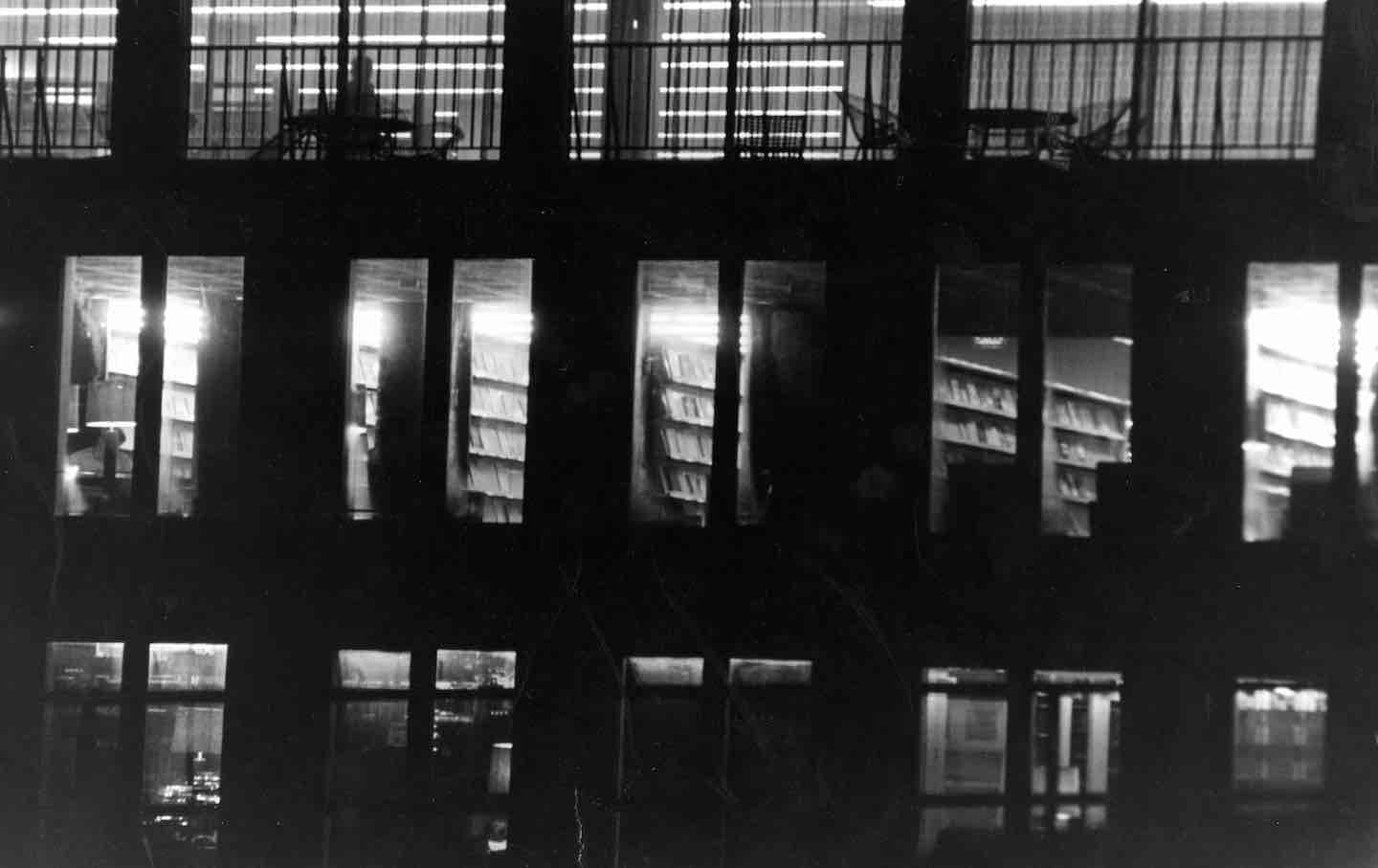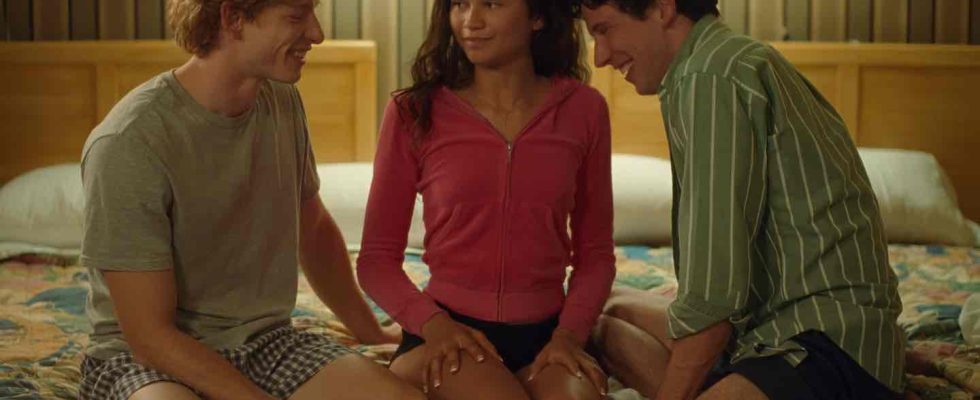Books & the Arts
/
May 1, 2024
What truly matters in Luca Guadagnino’s sexed-up tennis thriller is not the love triangle at its center but all the details that surround it.
Mike Faist as Art, Zendaya as Tashi and Josh O’Connor as Patrick in “Challengers.”
(Courtesy of Metro Goldwyn Mayer Pictures)
Tennis isn’t just a game—it’s a relationship, a thing that you share, something that happens between people. It’s a rare thing, Tashi Duncan (Zendaya) tells two boys she’s just met: In a match, you may see real tennis for only 15 seconds. It’s hard to understand exactly what she means until the end of Challengers, when you learn that tennis, to Tashi, is a form of raw interpersonal competition, distilled from wanting to kill someone or fuck them—or both. The intention to dominate is behind each swing of the racquet; it requires the physicality of someone who has never been hurt or has successfully forgotten that they can be.
Challengers—directed by Luca Guadagnino (Call Me by Your Name) and written by novelist and playwright Justin Kurtizkes —follows shifts in the relationships between Tashi and those two boys, Art Donaldson (Mike Faist) and Patrick Zweig (Josh O’Connor), and the changing fortunes (and rankings) of their tennis careers, which, for all of them, carries existential weight. They first meet at the 2006 Junior US Open at Arthur Ashe Stadium in Flushing, New York. Art and Patrick are competing as a doubles pair, then against each other in singles; Tashi, 18 years old, is already a superstar—her face on Adidas ads, fans with handmade signs in the stands to cheer her on. When Art and Patrick both pursue her, she surveys the tension (competitive, sexual) in their relationship by initiating and then cutting short a threesome in their hotel room, then makes a deal: The winner of their singles matchup the next day gets her number.
Patrick wins the tournament and thus the first round of his romantic rivalry with Art, but, after Tashi sustains a knee injury in college, they split up, in part thanks to his former doubles partner’s work to undermine the relationship. Years later, after the injury forces her to give up her professional career, Tashi becomes Art’s coach and, soon after, his wife. She coaches him to a series of high-profile tournament victories, but as he enters his 30s, he’s on a losing streak, and the couple’s dream of a career Grand Slam is slipping away. Tashi enters him into a small tournament in New Rochelle in which, unbeknownst to him, Patrick—down on his luck, sleeping in his car, still deeply devoted to tennis—is also competing. Both Art and Patrick make it to the final round, and years of lost intimacy and mistrust come to a head in the match in which all three have put their futures—their professional ambitions as well as the men’s relationships with Tashi and with each other—at stake.
As a sports film, Challengers works. Guadagnino has a good eye for the details that populate the lives of professional and semiprofessional athletes: a locker room full of surgery scars and purplish cupping marks, jars of electrolyte powders in a hotel suite kitchen and meticulously labeled pre-mixed bottles in the fridge, the whir of a single-serving blender, sunburnt fans in the stands and assistants with lanyards backstage that populate the artificial villages of professional sports. In their final standoff, Guadagnino contrasts Patrick and Art through their snacks: Patrick’s the kind of tennis player who eats a banana during a break (self-reliant, instinctive, hedonic, a little superstitious), while Art sucks down an energy gel packet (disciplined, organized, data-driven, rich).
And Challengers is worth watching for the cinematography alone, by Sayombhu Mukdeeprom, a frequent collaborator of both Guadagnino and the Thai director Apichatpong Weerasethakul. Mukdeeprom is skilled at creating lush, self-contained worlds, finely detailed surrealism without aloofness or distance. Tennis would seem like an out-of-the-box subject for him (and Guadagnino) but Mukdeeprom’s work in Challengers shows the continuity: the dilation of time and space in professional sports, the indispensability of the emotional and symbolic registers to really understand the game. At some moments, its visual language recalls the 2018 documentary John McEnroe: In the Realm of Perfection, a portrait of the volatile American tennis player drawn from footage collected by French Tennis Federation technical director Gil de Kermadec for a series of instructional videos, rich with unusual off-angle shots that highlight McEnroe’s idiosyncrasies. Mukdeeprom uses similar techniques of isolating heads or arms or feet, rather than capturing the entirety of the match in every shot, to magnify the players’ small, precise, repeated gestures; the tension in their jaws and shoulders; their sudden, ferocious outbursts of celebration, which they cut short and replace with sportsmanlike detachment.
Mukdeeprom’s most impressive feat is capturing impossible images of the game that feel somehow kinetically truer, realer than real. Balls zoom toward the camera, making you flinch; at one point, the camera takes on the perspective of a tennis ball and whizzes across the court, smacked by a racquet, whizzes back, bounces, flies through the air. Players’ footwork is shot from below through a transparent panel, it’s as if you’re watching them move from the perspective of the court’s surface itself. But, as compelling as the world of Challengers is, the film falls short in its central narrative project. As a study of a triangular relationship, the tension between each pole—Art and Patrick, Art and Tashi, Patrick and Tashi—is what animates the plot, but as the story progresses, it falters in capturing the film’s most interesting character: Tashi.
Current Issue

That’s not to say Tashi is passive. One available interpretation of the film’s final moments is that Tashi charts a path of emotional destruction through the lives of her husband and ex simply because she’s bored and wants to watch some great tennis. Seen through this lens, her encounter with Art and Patrick in the hotel room was less about immediate gratification than lighting a Molotov cocktail of desire and confusion and competitiveness in the pair’s relationship so she could watch them lob it back and forth across the court the next day. In the present, Art’s ambivalence about pursuing professional tennis motivates Tashi to engage in a series of riskier decisions to restore it. “We can just be rich people, if that’s all you think you can handle,” she tells him, “or you can be a tennis player,” in a tone that clearly communicates that the former isn’t an option.
A character study of a tennis sociopath or the world’s least ethical sports psychologist could be amazing; at the very least, it could have the dramatic excess that makes for great camp. But the factors that would drive someone to that decision would resound throughout the rest of their personality, and Challengers is not the film to show it. Tashi’s most memorable piece of characterization is in the first act, when she wears a glittery royal-blue dress to a brand-sponsored party held in her honor and dances to Nelly’s “Hot in Herre” with moves that wouldn’t look out of place at a sweet sixteen. After a commanding tennis performance, it takes you off-guard—behind the athlete with the killer backhand and the on-court swagger is a girl who’s been a celebrity for most of her teenage years and has probably never been to a normal party.
Beyond that moment, the nuance slips away. Tashi is powerful, but she’s a cipher, a force of nature. Art and Patrick want her, and she wants them to shut up and play. She’s like a primordial mother goddess who occupies a plane of existence wholly other than Art and Patrick, whose emotions seem, in comparison, petty and self-centered. Her reasoning is obscure and indisputable; she sets the terms of their relationships, with her and with each other. The film makes frequent use of euphemistic conversations about tennis that could also be about sex, but with Tashi, it’s always about tennis. She can withstand more pressure than either Art or Patrick, but without an outlet of her own, it renders her weary rather than heroic.
In her 1985 book Between Men, queer theorist Eve Kosofsky Sedgwick analyzes what she terms “male homosocial desire” as a driving narrative force in English literature, a kind of bond that “uses a woman as a ‘conduit of a relationship’ in which the true partner is a man.” In this schema, masculine bonds and masculine identity necessarily take shape in relation to women: In simpler terms, for men to enjoy a certain kind of frisson, a woman needs to be in the picture. (The marketing for Challengers, which heavily emphasizes the abortive threesome, understands this.) In Challengers Guadagnino provides so many moments in which Art and Patrick glory in each other’s company, like two dogs who are best friends—crawling and tumbling over and kissing each other after a win, snarling at each other from across the net. In contrast, there are few of these moments of physical ebullience with Tashi, whom Zendaya plays in the character’s adult years as a tense chord of exhaustion and ambition, resigned to never meet her match on or off the court and reckless because of it.
In some of the texts Sedgwick analyzes, she writes that, for a brief moment, “the transaction appears to be between a woman so powerful, and a man so powerless, that no subsequent use of the power that has been ceded to the man could ever endanger the woman’s interests.” But this moment of agency ebbs to the conventions of the time; the female role becomes “a solvent” through which “men are able to exchange power and to confirm each other’s value even in the context of the remaining inequalities in their power,” a role that “goes a long way…toward palliating [the relationship’s] gaps and failures.” While the film maintains a pulse of homoeroticism—Art and Patrick share a profound physical knowledge of each other, and you wonder, as Tashi wonders, if it will ever extend to literal sex—fans of Guadagnino’s oeuvre will be disappointed to find that the gayest character in Challengers is the camera. All their sexual tension is routed through Tashi, which makes her the grounds for their reconciliation.
You never really learn why Tashi is the way she is—why she’s so strongly motivated by tennis and why she chooses Art and Patrick as her proxies to express it. That isn’t necessarily a problem on its own—I don’t think every character needs biographical exposition to be compelling—but one senses that Guadagnino doesn’t know, either; it’s easier if the source of Tashi’s power is opaque. You learn more about her values from her scorn for 31-year-old, washed-up Patrick than anything she says about herself. She matters in this story as a conductor of intimacy between boys. She magnifies and redirects phenomena of considerable force and velocity: a powerful instrument, but an instrument nonetheless. You wonder what she’d do without Art and Patrick, but Challengers makes it impossible to imagine.
Thank you for reading The Nation!
We hope you enjoyed the story you just read. It’s just one of many examples of incisive, deeply-reported journalism we publish—journalism that shifts the needle on important issues, uncovers malfeasance and corruption, and uplifts voices and perspectives that often go unheard in mainstream media. For nearly 160 years, The Nation has spoken truth to power and shone a light on issues that would otherwise be swept under the rug.
In a critical election year as well as a time of media austerity, independent journalism needs your continued support. The best way to do this is with a recurring donation. This month, we are asking readers like you who value truth and democracy to step up and support The Nation with a monthly contribution. We call these monthly donors Sustainers, a small but mighty group of supporters who ensure our team of writers, editors, and fact-checkers have the resources they need to report on breaking news, investigative feature stories that often take weeks or months to report, and much more.
There’s a lot to talk about in the coming months, from the presidential election and Supreme Court battles to the fight for bodily autonomy. We’ll cover all these issues and more, but this is only made possible with support from sustaining donors. Donate today—any amount you can spare each month is appreciated, even just the price of a cup of coffee.
The Nation does not bow to the interests of a corporate owner or advertisers—we answer only to readers like you who make our work possible. Set up a recurring donation today and ensure we can continue to hold the powerful accountable.
Thank you for your generosity.
More from The Nation

A new collection of essays from academics and activists devoted to prison abolition focuses on the quiet but rapid expansion of the carceral system in small towns and municipaliti…
Books & the Arts
/
Jarrod Shanahan

A history of comedy’s last three decades of pop culture dominance argues that it is among the consequential American art forms.
Books & the Arts
/
Ginny Hogan

The Nation speaks to Jessi Jezewska Stevens about her new short-story collection, which dramatizes late-capitalist living.
Q&A
/
Rose D’Amora

An ode to one of the greatest working-class art forms of our time.
Comment
/
Kim Kelly

By looking at the labor history of academia, you can see the roots of a crisis in higher education that has been decades in the making.
Books & the Arts
/
Erik Baker

